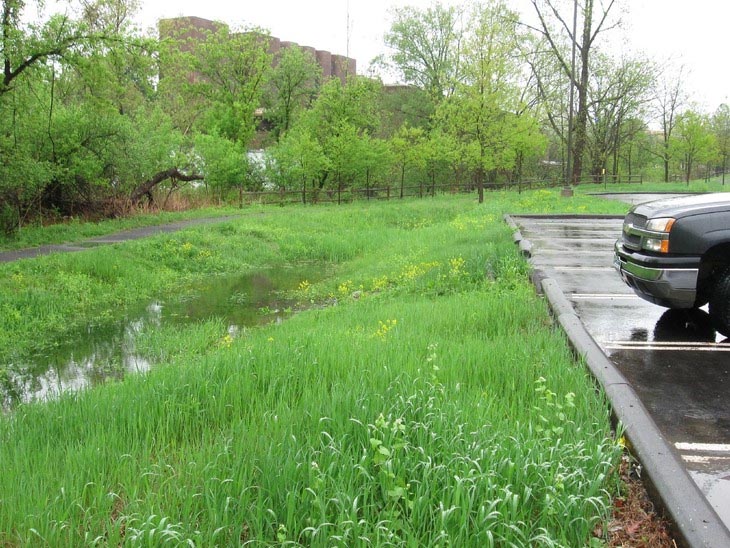
A dry detention basin next to a road to collect runoff, prevent flooding and perhaps control nitrate infiltration of groundwater. IMAGE: LAUREN E. MCPHILLIPS/PENN STATE
Detention basins could catch more than stormwater
8/12/2019
By A’ndrea Elyse Messer
LOUISVILLE, Ky. — Everywhere you go there are stormwater detention basins built near large construction projects intended to control the flow of rainwater and runoff. Now, those basins might help in controlling nitrogen runoff into rivers and lakes, according to Lauren E. McPhillips, assistant professor of civil and environmental engineering at Penn State.
Speaking today (Aug. 12) at the annual meeting of the Ecological Society of America in Louisville, Kentucky, she explained that she and colleagues at Cornell University looked at stormwater detention basins in the area around Ithaca, New York.
“Part of the goal for stormwater detention basins is to manage flow,” said McPhillips. “Increasingly, we are trying to get more water quality goals out of them.”
Controlling runoff from rain and trapping sediment has always been a goal of these ubiquitous basins, but new techniques may make them suitable for removing nitrate from the water as well. The basins the researchers examined are in urban and suburban areas, and nitrate comes from atmospheric deposition on roads, car combustion and lawn fertilizers.
“These basins have always been treated as black boxes looking at water in and percentage efficiency,” said McPhillips. “However, different designs of these basins perform differently, and now we are looking at performance and specific mechanisms for removal of nitrogen.”
Nitrogen is the target because, while our atmosphere is composed of 78% gaseous nitrogen, other forms of the element like nitrate cause overgrowth of algae in bodies of water. This eutrophication removes oxygen from the water and creates underwater deserts where fish and other water creatures cannot live.
In general, stormwater basins are either wet basins or dry basins. Water passes through dry basins in a few days, while wet basins have standing water for much longer. A variety of things can happen to the nitrate in the basin. It can pass into the groundwater and then to rivers, streams and lakes; it can be taken up by vegetation; or it can be converted to other compounds by microbes living in the basins.
While decay of basin vegetation places the nitrate back into the basin and the groundwater, some microbial assemblages can convert nitrate all the way to gaseous nitrogen, removing it. The researchers sampled the basins and checked microbial DNA for a gene that can allow conversion of nitrate to nitrogen gas. This gene produces an enzyme that can convert nitrate into gaseous nitrogen.
“Typically, the basins are designed to be dry, but as sediment from runoff and vegetation that grows in the basins builds up, they can become wet basins,” said McPhillips.
They found that the capability of producing gaseous nitrogen was higher in wet basins than dry basins. However, they also found that partial conversion produced nitrous oxides and that consumption of organic matter produces methane, both greenhouse gases. The wet basins showed higher levels of the gene that allows complete conversion of nitrate to gaseous nitrogen.
According to McPhillips, designing the basins to hold water from the beginning could decrease production of nitrous oxides, because the longer the basins hold the water, the more complete the conversion from nitrate to gaseous nitrogen.
As for the methane, McPhillips suggests that engineering the basins so that the water retention layer is below ground and not on the surface of the basin could prevent the methane from releasing into the atmosphere. Trapped in the soil, oxygen would degrade the methane.
McPhillips is now looking at stormwater retention basins on Penn State’s University Park campus for further research.
Also working on this project were M. Todd Walter, professor of biological and environmental engineering at Cornell University; and Natalie Morse, a recent doctoral recipient from Cornell University.
The National Science Foundation supported this work.





